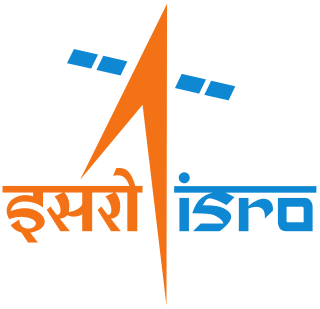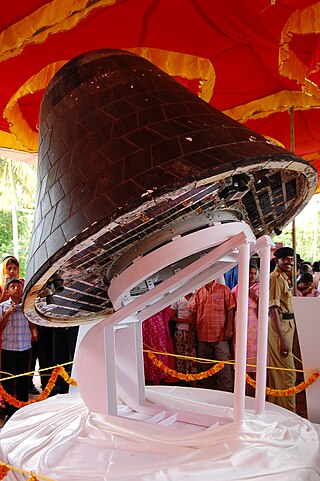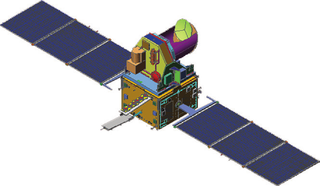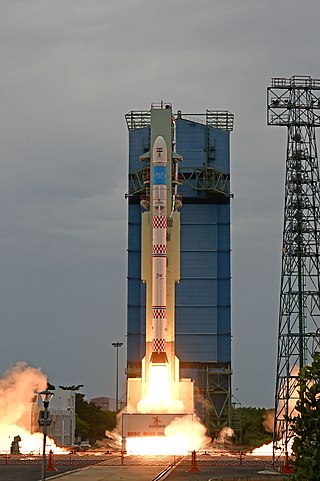
The Polar Satellite Launch Vehicle (PSLV) is an expendable medium-lift launch vehicle designed and operated by the Indian Space Research Organisation (ISRO). It was developed to allow India to launch its Indian Remote Sensing (IRS) satellites into Sun-synchronous orbits, a service that was, until the advent of the PSLV in 1993, only commercially available from Russia. PSLV can also launch small size satellites into Geostationary Transfer Orbit (GTO).

The Indian Space Research Organisation is India's national space agency. It serves as the principal research and development arm of the Department of Space (DoS), overseen by the Prime Minister of India, with the Chairman of ISRO also serving as the chief executive of the DoS. It is primarily responsible for space-based operations, space exploration, international space cooperation and the development of related technologies. The agency maintains a constellation of imaging, communication and remote sensing satellites. It operates the GAGAN and IRNSS satellite navigation systems. It has sent three missions to the Moon and one mission to Mars.

Satish Dhawan Space Centre – SDSC is the primary spaceport of the Indian Space Research Organisation (ISRO), located in Sriharikota, Tirupati district, Andhra Pradesh.

The Space Capsule Recovery Experiment is an Indian experimental spacecraft which was launched at 03:53 UTC on January 10, 2007, from Sriharikota by the Indian Space Research Organisation (ISRO). The launch was conducted using the C7 launch of the PSLV rocket, along with three other satellites. It remained in orbit for 12 days before re-entering the Earth's atmosphere and splashing down into the Bay of Bengal at 04:16 UTC on January 22.

Indian Regional Navigation Satellite System (IRNSS), with an operational name of NavIC, is an autonomous regional satellite navigation system that provides accurate real-time positioning and timing services. It covers India and a region extending 1,500 km (930 mi) around it, with plans for further extension up to 3,000 km (1,900 mi). An extended service area lies between the primary service area and a rectangle area enclosed by the 30th parallel south to the 50th parallel north and the 30th meridian east to the 130th meridian east, 1,500–6,000 km (930–3,730 mi) beyond borders where some of the NavIC satellites are visible but the position is not always computable with assured accuracy. The system currently consists of a constellation of eight satellites, with two additional satellites on ground as stand-by.

A halo orbit is a periodic, three-dimensional orbit associated with one of the L1, L2 or L3 Lagrange points in the three-body problem of orbital mechanics. Although a Lagrange point is just a point in empty space, its peculiar characteristic is that it can be orbited by a Lissajous orbit or by a halo orbit. These can be thought of as resulting from an interaction between the gravitational pull of the two planetary bodies and the Coriolis and centrifugal force on a spacecraft. Halo orbits exist in any three-body system, e.g., a Sun–Earth–orbiting satellite system or an Earth–Moon–orbiting satellite system. Continuous "families" of both northern and southern halo orbits exist at each Lagrange point. Because halo orbits tend to be unstable, station-keeping using thrusters may be required to keep a satellite on the orbit.

Megha-Tropiques was a satellite mission to study the water cycle in the tropical atmosphere in the context of climate change. A collaborative effort between Indian Space Research Organisation (ISRO) and French Centre National d’Etudes Spatiales (CNES), Megha-Tropiques was successfully deployed into orbit by a PSLV rocket in October 2011.

Aditya-L1 is a coronagraphy spacecraft for studying the solar atmosphere, designed and developed by the Indian Space Research Organisation (ISRO) and various other Indian Space Research Institutes. It is orbiting at about 1.5 million km from Earth in a halo orbit around the Lagrange point 1 (L1) between the Earth and the Sun, where it will study the solar atmosphere, solar magnetic storms, and their impact on the environment around the Earth.

Mars Orbiter Mission (MOM), unofficially known as Mangalyaan, is a space probe orbiting Mars since 24 September 2014. It was launched on 5 November 2013 by the Indian Space Research Organisation (ISRO). It was India's first interplanetary mission and it made ISRO the fourth space agency to achieve Mars orbit, after Soviet space program, NASA, and the European Space Agency. It made India the first Asian nation to reach Martian orbit and the second national space agency in the world to do so on its maiden attempt after the European Space Agency did in 2003.
PSLV-C34 was the 36th mission of the PSLV program and 14th mission of PSLV in XL configuration. The PSLV-C34 successfully carried and deployed 20 satellites in the Sun-synchronous orbit. With a launch mass of 320,000 kilograms (710,000 lb) and payload mass of 1,288 kilograms (2,840 lb), the C34 set a new record of deploying the maximum number of satellites by Indian Space Research Organisation in a single mission. The PSLV-C34 carried One Cartosat-2 satellite, SathyabamaSat, Swayam & 17 other satellites from United States, Canada, Germany & Indonesia.
KITSAT-3 was a South Korean remote sensing minisatellite which carried MEIS and SENSE instruments to low Earth orbit (LEO). Launched on 26 May 1999 by Indian space agency Indian Space Research Organisation (ISRO), on orbit the satellite was renamed to Uribyol-3. Manufactured by KAIST Satellite Technology Research Center (SaTReC), KITSAT-3 was developed with experience from KITSAT-1 and KITSAT-2 and was the first independently designed South Korean satellite.

PSLV-C37 was the 39th mission of the Indian Polar Satellite Launch Vehicle (PSLV) program and its 16th mission in the XL configuration undertaken by the Indian Space Research Organisation (ISRO). Launched on 15 February 2017 from the Satish Dhawan Space Centre at Sriharikota, Andhra Pradesh, the rocket successfully carried and deployed a record number of 104 satellites in Sun-synchronous orbits in a single mission, breaking the earlier record of launching 37 satellites by a Russian Dnepr rocket on 19 June 2014. This record was held until the launch of the Transporter-1 mission by SpaceX on 24 January 2021 which launched 143 satellites.

The Small Satellite Launch Vehicle (SSLV) is a small-lift launch vehicle developed by the Indian Space Research Organisation (ISRO) to deliver 500 kg (1,100 lb) payload to low Earth orbit or 300 kg (660 lb) payload to Sun-synchronous orbit. The rocket supports multi-orbital drop-offs capability for small satellites.

The X-ray Polarimeter Satellite (XPoSat) is an Indian Space Research Organisation (ISRO)-manufactured space observatory to study polarisation of cosmic X-rays. It was launched on 1 January 2024 on a PSLV rocket, and it has an expected operational lifespan of at least five years.

The PSLV-C54 was the 56th mission of the Indian Space Research Organisation's Polar Satellite Launch Vehicle (PSLV). It was launched on 26 November 2022 with the Oceansat-3 satellite and Thybolt nanosatellites of Dhruva Space from Satish Dhawan Space Centre, Sriharikota, Andhra Pradesh, India.

The PSLV C-58 was the 60th flight of the Indian Space Research Organisation's Polar Satellite launch Vehicle. It carried the XPoSAT mission along with rideshare payloads.














